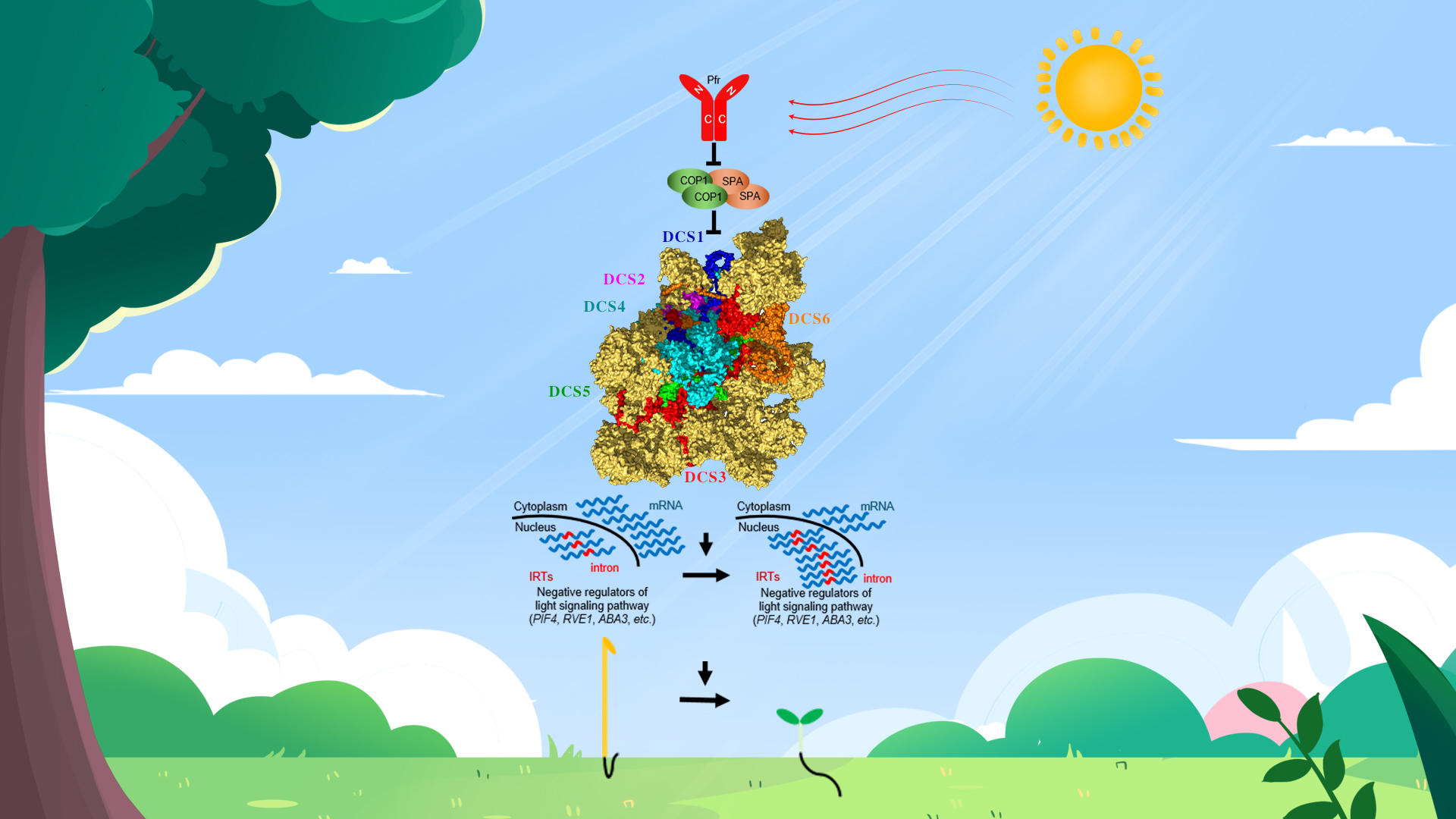Researchers reveal novel mechanism involved in regulating photomorphogenesis via light-COP1-spliceosome module in Arabidopsis
DATE:2024-06-26
Light is the material basis on which all living things depend. Light is not only an energy source for plants; it is also a signal that directly participates in the regulation of plant growth and development. Photomorphogenesis, characterized by hypocotyl elongation inhibition, the disappearance of apical hooks, and the expansion of cotyledons with well-developed chloroplasts, is a light-dependent process that regulates plant growth and development.
CONSTITUTIVE PHOTOMORPHOGENIC 1 (COP1) is a core repressor of the light signaling pathway. COP1, acting as an E3 ligase, targets a series of substrates for ubiquitination and degradation to inhibit photomorphogenesis. In addition, COP1 also widely participates in and regulates a series of plant growth processes, including flowering, stomatal development, and biological rhythm. Therefore, COP1 is essential for growth and development.

Chair Professor Xing Wang Deng’s research team from the Department of Biology at the Southern University of Science and Technology (SUSTech) has recently revealed a novel mechanism involved in regulating photomorphogenesis via the light-COP1-spliceosomes module in Arabidopsis.
To identify more factors involved in COP1 signaling pathways, the researchers performed EMS mutagenesis on cop1-6, a weak allele mutant, to screen for genetic suppressors that can repress the cop1-6 phenotype in the dark. Through mapping and whole-genome re-sequencing of 13 dominant cop1-6 suppressors, the researchers cloned 6 Dominant cop1-6 Suppressor (DCS) genes.
Their work, entitled “Light regulates nuclear detainment of intron-retained transcripts through COP1-spliceosome to modulate photomorphogenesis”, has been published in Nature Communications.
Intron retention (IR) is the most common alternative splicing event in plants. IR plays an important role in the regulation of gene expression. It has been found that intron-retained transcripts (IRTs) can be retained in the nucleus to avoid being translated into new proteins or degraded. Upon external stimulus and developmental phase changes, the nuclear-retained IRTs can be fully spliced and translocated into the cytoplasm for translation. Without transcribing mRNA de novo, this regulatory mechanism represents a quicker response to surrounding changes and the developmental phase transition.
This study uncovers that COP1 is involved in light-mediated pre-mRNA alternative splicing, mainly IR, to coordinate plant photomorphogenesis. COP1-dependent light modulation of the IRTs of light signaling genes, such as PIF4, RVE1, and ABA3, contribute to seedling morphological development in response to changing light conditions. Furthermore, light-induced IR changes are under the control of the spliceosome, and in part through COP1-dependent ubiquitination and degradation of DCS1, a plant-specific spliceosomal component. Therefore, this work reveals a novel molecular mechanism involved in regulating photomorphogenesis via the light-COP1-spliceosomes module in Arabidopsis.

Figure 1. The molecular mechanism involved in regulating photomorphogenesis via the light-COP1-spliceosomes module
Research Assistant Professor Hua Zhou from SUSTech is the first author of this paper. Chair Professor Xing Wang Deng is the corresponding author, and SUSTech is the first affiliated unit.
Other contributors to this work included Professor Ning Wei from Southwest University, Professors Dongqing Xu and Sunlu Chen from Nanjing Agricultural University, Professor Fang Lin from Lanzhou University, Professor Guochen Qin from the Peking University Institute of Advanced Agricultural Sciences (PKU-IAAS), Professor Jian Li from Nanjing Normal University, Professor Yueqin Heng from the South China Agricultural University, Dr. Xianhai Zhao from the Brookhaven National Laboratory in the United States, Dr. Tingting Yan from the Hainan Academy of Agricultural Sciences, along with doctoral student Haiyue Zeng and Research Assistant Ying Fu from PKU-IAAS.
The research was supported by the National Natural Science Foundation of China (NSFC), Shenzhen Science and Technology Program, Key Laboratory of Molecular Design for Plant Cell Factory of Guangdong Higher Education Institute, National Key R&D Program of China, and SUSTech.
Paper link: https://www.nature.com/articles/s41467-024-49571-9
To read all stories about SUSTech science, subscribe to the monthly SUSTech Newsletter.
latest news
-
Dynamic changes in transposable elements shape human three-germ-layer differentiation
Date:2025-09-04
-
Researchers collaborate to uncover how SOD1 protects lysosome through autophagy
Date:2025-08-26
-
Researchers find 5-IP7 disrupts intestinal epithelial barrier and drives inflammation-induced colorectal cancer
Date:2025-08-26
-
Researchers decode molecular architecture and inhibition mechanism of human taurine transporter
Date:2025-08-22
